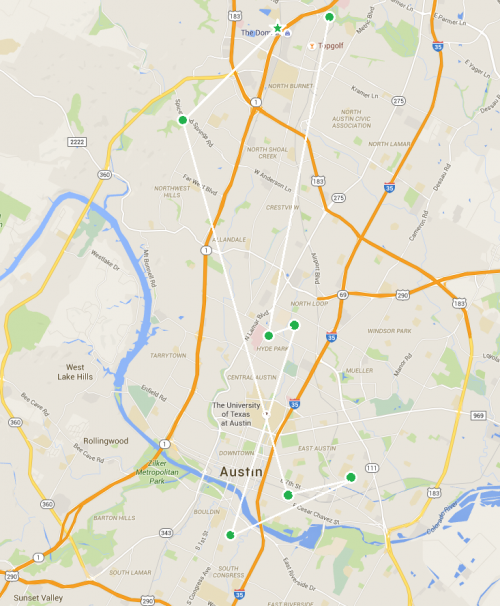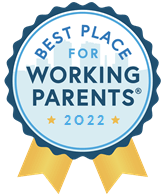Why is Austin So Unaffordable?
Willie Cecil is the CEO of Cecil Logistics and Chair of the Economic Development Committee. This blog post represents the view of Mr. Cecil and his views alone. To find out more about the Economic Development Committee and their work, RSVP for their next meeting on September 28th.
It’s a question many young people have asked, but few have examined. As recently as yesterday, I have been looking for a new place to live. My lease is up at the end of August, and I have been a renter here since I first moved to Austin in 2009.
But from the time I arrived 7 years ago, and despite my income increasing over that time, I have actually ended up further away from central Austin than when I first arrived here for an internship while working nights as a bouncer at Cain & Abel’s. Here’s what that looks like:

The realities of living that far away nowadays are absolutely draining. What was a 20 minute commute by bus or bicycle from Hyde Park to downtown turned into an hour and fifteen minutes. While I could choose to not use a car in Hyde Park, living on Gracy Farms Ln requires me to have one. With Mopac being my only thoroughfare for all my North-South trips, the entire central city of Austin was essentially shut off to me between the hours of 7:30-9:30 AM and 3:30-6:30 PM, sometimes longer. As someone who started a courier business the year before and supplemented it with rideshare income, this was devastating to my bottom line.
Let me be clear. This article is not about what I don’t like about Austin. In fact, I love Austin and its entrepreneurial spirit. I can and will adjust, manage to continue making my own money, and am pursuing projects that do not involve cars or deliveries. My goal here is not to complain. But I have to paint a picture of the realities of the current situation, something many millennials are feeling the effects of, and examine why it’s happening in the hopes of doing something about it. As early as 2 years ago, I didn’t have months where I barely squeaked by. 4 years ago, I didn’t have to have a roommate if I planned on living anywhere remotely close to downtown — or even clean for that matter. Something needs to change.
What’s Causing All of This?
The amount of answers to this is as diverse as the question is complex, but a few central themes continue to spring up:
- Current housing supply doesn’t meet demand
- Our land use code is burdensome and complicated
- Most local neighborhood associations are fierce obstructionists to new density
- Several “missing-middle” options that could add housing are not currently allowed
Let’s tackle these one by one.
Supply and Demand
Austin faces a very unique problem: people keep wanting to move here. While many might not like that, we’re lucky to have that problem. Look to Detroit as a case study of what happens when the opposite takes place. Yet that influx is causing a strain on housing prices. Many find they can’t afford to live close to where they work, play, shop, or study. A quick MLS search of available studio and 1-bedroom apartments in central Austin, some as small as under 400 square feet, are going for upwards of $1100/month in rent. Backyard cottages, mostly bereft of the amenities apartment complexes can sometimes provide, are often in the same price range. I can’t think of many people that would pay that much for that little unless they had to.
An obvious solution is to increase housing supply as quickly as possible, but here’s where we begin reaching obstacles.
Land Use Complications
If you are ever having trouble sleeping, watching a presentation on the land use code in Austin would probably fix your insomnia pretty quickly. It’s not a sexy topic, but it is hugely important. This codifies the minimum and maximum dimensions of, as a small example: distance between structures, the structure’s height, the structure’s composition (amount of units), the lot size needed to build additional units, the driveway width, carport limits, drainage requirements, handicapped accessibility, permitted landscaping, which trees can be knocked down, you name it. Ever seen a suburban neighborhood where all the houses have the same types of bricks? This is why.
For 30 years, zoning changes in Austin area have added additional uses, along with additional requirements for compliance, called overlays, to specific units or swaths of units throughout town. The result has become situations where your house or place of business can have up to 4 types of overlays. There are now over 400 combinations of zoning uses in Austin. This has gotten so complicated, developers are often opting for the PUD zoning distinction (public utility district) so they can make better use, in their opinion, of land they want to develop. Mueller is an example of this. Some surrounding neighbors, however, would argue they’re trying to skirt the rules.
Beginning, ????, End
Further complicating things, is Austin’s prohibition of certain types of housing uses on certain types of zones, namely single-family lots. Our current code does not allow for more than two units to be developed on a single-family zone, and has had restrictions to building backyard cottages in the past that often excluded many places where they could otherwise be built.
The result is that the code compliance needed for building 3 units is the same as for building 300 units, causing space and height limitations, and making building anything between those two unit amounts often financially untenable. Nearly everything between single-family homes and mid-rises is not currently allowed on single-family lots, no matter the lot size.
Arguably, this caused single-family neighborhood bubbles to spring up in central Austin that both limited the access to Austin’s central core and prevented further density. Meanwhile, most multi-family development and suburban development was relegated to the surrounding areas, causing outlying pockets of poverty with woefully low access to large chunks of the city or necessities such as groceries.
The City of Austin is working with consultants on CodeNEXT, which is hoping to allow units such as the ones below to be allowed on single-family lots. Something it dubs “the missing middle”.

Opponents of including these types of housing use arguments that do have merit. Increased density will add burdens to police, schools, parks, and utilities. Moreover, they would change the look and feel of the neighborhoods over time – there is without a doubt a trade-off. But a quick glance at the data tells a story that cannot continue.
Anyone’s Backyard but Mine
I’ll be the first to admit that change is scary. A constant theme since I arrived in Austin has been “you should have seen how cool it was before you got here.” I guess I am part of the problem in that regard. But if I am, then according to the most recent Zandan poll, so are 61% of the people like me under the age of 35. More telling is that 65% of us don’t live in Central Austin, and a full 87% of people over 35, a vast majority of those able to purchase housing, don’t (or can’t) live in Central Austin either. That’s as astounding as it is unsustainable.
Yet neighborhood associations often remain vehemently opposed to adding housing units, pushing for measures such as allowing neighborhoods to opt-out the entire neighborhood from building new ADU’s, even if city code allowed for more, for adding a requirement for a 75% approval from council for a PUD if the Planning Commission recommended denial by simple majority, or, even if the Planning Commission did recommend approval, forcing a 75% majority vote at Council for the PUD if 20% of people within 200 feet of the development raised an objection, raising a significant institutional hurdle.
Barring even that, when the Bull Creek Road Coalition tried to raise that exact objection for The Grove at Shoal Creek only to discover that it didn’t apply to previously unzoned land (the land used to be owned by the State of Texas), they tried to pass an ordinance to have it apply and then opted to sue the City when they were unsuccessful.
Where Do We Stand?
That remains to be determined. Bottom line is that the most vocal groups when it comes to new development have largely been non-renters (homeowners over the age of 50), and they are often openly hostile to these programs, as demonstrated above. As Mary Ingle, President of the Austin Neighborhood Council recently summarized the sentiment, “They want our homes, they want our land, and they want our zoning. That’s offensive to neighborhoods.”
Many groups share her opinion. I’m curious if the young renters of Austin are one of them.
I’ve laid before you the issues facing housing here in our great city, one I have grown to love and was infatuated with well before I moved here, and I’d like to ask your input on what to support moving forward.
I invite you to join the Austin Young Chamber, and attend the Economic Development Committee meeting occurring every last Wednesday at 6:30 PM at WeWork University Park. Our next meeting will be Wednesday, September 28th and all prospective and current Young Chamber members are welcome to join.
There we will discuss, among other things, whether to endorse projects such as The Grove at Shoal Creek, projects similar to it, and what positions to take on CodeNext, our city’s current land code rewrite efforts. After all, we will be the ones to inherit this city and its neighborhoods. It’s time we make our voices heard, too.


2 Comments
I think the primary driver in communities resistance to increasing density, through any variety, is not that they’re changing the dynamic of the neighborhood, but that in increasing supply they will devalue their greatest asset. For existing home owners in Austin, many of whom have purchased homes in the not so distant, more affordable, past – having the value of your home double or triple represents a massive increase in their Net Worth.
I just read this really similar article this morning about Silicon Valley: http://www.theatlantic.com/business/archive/2016/08/former-palo-alto-planner-on-silicon-valley-housing/496274/?utm_source=atlgp
Seems like a pattern. What I like about the article about Silicon Valley is that it brings in the aspect of low-paid social service workers and other industries that you can’t have a functioning city without, but will get pushed out of living here without affordable housing options.